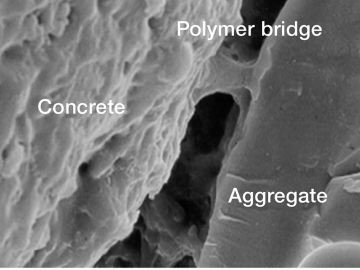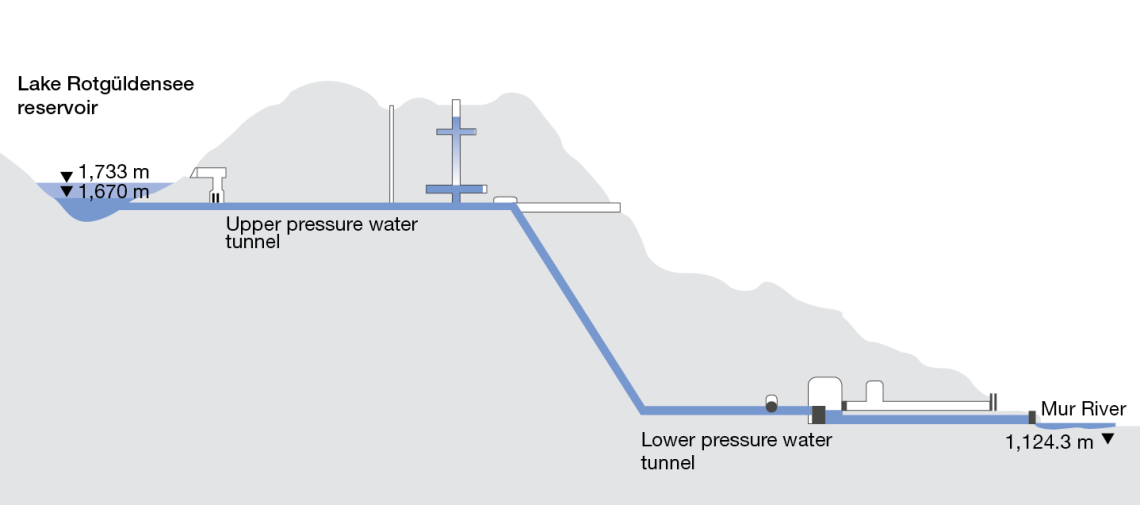
Tunneling Troubleshooters
Ten years ago, the application researchers at WACKER began testing new modifiers for sprayed concrete. They had a clear goal, namely to increase productivity in tunneling. How did customers benefit?
Entering the Hagerbach Test Gallery in Flums, Switzerland, you are stepping into the future. This is where they test the materials for tomorrow’s tunnels – against water pressure, acidity, heat, cold or for processability. Here, entire tunnel sections are replicated. Since 2008, WACKER has also tested the effect of its ETONIS® concrete additive here. A first interesting finding was that only two percent of the modifier significantly improves the adhesion of the sprayed concrete. Why is that important? Sprayed concrete is applied at high pressure. which highly compacts the concrete, making it substantially water impermeable. However, the pressure also causes a large amount of the material to rebound. Nevertheless, the increased adhesion has such a strong influence on the rebound that even WACKER’s sprayed concrete experts were astonished. Adding 2 to 7.5 percent ETONIS® reduced rebound by a half or more, depending on the particular concrete mix. This represents a considerable material saving. At the same time, the amount of spoil is reduced. Both of these are music to the ears of the tunnelers, since waste disposal in a confined space is very time consuming. And in tunneling, time is almost everything.

Under optimum conditions, a tunnel boring machine advances by about 40 meters per day. On other days, it may be only one meter, depending on the geology. The TBM operator’s concern is therefore to reduce downtimes in order to avoid delays. With ETONIS®, everything runs smoothly on site. The polymer modifiers improve the pumpability of the concrete, so there is less risk of blockage. Larger amounts of sprayed concrete can therefore be processed within a shorter time.

Modified Sprayed Concrete under the Microscope
The polymer film strengthens the bond between concrete and aggregate, and between concrete and the substrate. This give sprayed concrete the necessary flexibility for crack-bridging and improves its adhesion.
Water barrier for the Metro in Rio de Janeiro
ETONIS® has just left the experimental stage. The new modifier has gained a reputation around the world as a troubleshooter in tunneling. When Rio de Janeiro extended its Metro Line 4 for the 2014 Olympic Games, the engineers were faced with difficult geology, specifically arenaceous rock. To be on the safe side, the walls were immediately stabilized with sprayed concrete during the advance. Nevertheless, water still penetrated through the tunnel lining in some places. WACKER’s ETONIS® product provided a quick solution. Within a few days, the wet walls had been remediated. A mix containing ten percent ETONIS® was used for this. The high polymer concentration ensured that the concrete bonded securely to the wet tunnel wall. At the same time, it was known from earlier tests that modified concrete in this concentration forms a reliable water barrier.
Remediation of a pressure tunnel in Austria.
The reliable waterproofing effect of ETONIS® in tunnels and canals is demonstrated by another example: the Hintermuhr pumped storage power plant near Salzburg. It mainly acts as a buffer. When consumption is low, water is pumped up to a lake at a higher elevation, so that it will be available for generating electricity during peak demand. The power station also prevents flooding in lower lying villages. In 2009, water loss was registered in the pressure water tunnel, meaning a quick remediation was necessary, since snow thaw was due. For this purpose, the pressure water tunnel was first drained dry. Then the tunnel tube was sealed by dry-mix spraying. Because the tunnel needed to be watertight, the concrete was modified with 7.5% ETONIS®. This also had the advantage of reducing the rebound by 50%. Instead of the calculated 308 hours for hauling off the spoils, only 152 hours were required. Thanks to this, the remediation was completed before the snow started melting.

The pressure water tunnel runs through the mountain and is only 4 meters across, making dry spraying the only feasible option. To stop leaks, it was sufficient to modify with 7.5 percent ETONIS®.
Are you interested in our ETONIS® products?
ETONIS® modifiers give sprayed concrete outstanding properties. They are particularly effective for wet rock or structures in contact with groundwater. For more information, see our product portal..
More about ETONIS®




